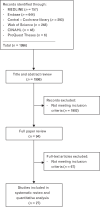The postoperative analgesic efficacy of liposomal bupivacaine versus long-acting local anaesthetics for peripheral nerve and field blocks: A systematic review and meta-analysis, with trial sequential analysis
- PMID: 37038770
- PMCID: PMC10860892
- DOI: 10.1097/EJA.0000000000001833
The postoperative analgesic efficacy of liposomal bupivacaine versus long-acting local anaesthetics for peripheral nerve and field blocks: A systematic review and meta-analysis, with trial sequential analysis
Abstract
Background: Liposomal bupivacaine is claimed by the manufacturer to provide analgesia for up to 72 h postoperatively.
Objectives: To compare the postoperative analgesic efficacy of liposomal bupivacaine versus long-acting local anaesthetics for peripheral nerve or field blocks.
Design: A systematic review and meta-analysis with trial sequential analysis.
Data sources: MEDLINE, Embase and Web of Science, among others, up to June 2022.
Eligibility criteria: We retrieved randomised controlled trials comparing liposomal bupivacaine versus bupivacaine, levobupivacaine or ropivacaine for peripheral nerve and field blocks after all types of surgery. Our primary endpoint was rest pain score (analogue scale 0 to 10) at 24 h. Secondary endpoints included rest pain score at 48 and 72 h, and morphine consumption at 24, 48 and 72 h.
Results: Twenty-seven trials including 2122 patients were identified. Rest pain scores at 24 h were significantly reduced by liposomal bupivacaine with a mean difference (95% CI) of -0.9 (-1.4 to -0.4), I2 = 87%, P < 0.001. This reduction in pain scores persisted at 48 h and 72 h with mean differences (95% CI) of -0.7 (-1.1 to -0.3), I2 = 82%, P = 0.001 and -0.7 (-1.1 to -0.3), I2 = 80%, P < 0.001, respectively. There were no differences in interval morphine consumption at 24 h ( P = 0.15), 48 h ( P = 0.15) and 72 h ( P = 0.07). The quality of evidence was moderate.
Conclusions: There is moderate level evidence that liposomal bupivacaine reduces rest pain scores by 0.9 out of 10 units, when compared with long-acting local anaesthetics at 24 hours after surgery, and by 0.7 up to 72 hours after surgery.
Copyright © 2023 European Society of Anaesthesiology and Intensive Care. Unauthorized reproduction of this article is prohibited.
Figures



Comment in
-
Liposomal bupivacaine: Defining efficacy, how effective is effective?Eur J Anaesthesiol. 2023 Sep 1;40(9):622-623. doi: 10.1097/EJA.0000000000001879. Eur J Anaesthesiol. 2023. PMID: 37530714 No abstract available.
Similar articles
-
Liposomal bupivacaine infiltration at the surgical site for the management of postoperative pain.Cochrane Database Syst Rev. 2017 Feb 1;2(2):CD011419. doi: 10.1002/14651858.CD011419.pub2. Cochrane Database Syst Rev. 2017. PMID: 28146271 Free PMC article.
-
Liposomal bupivacaine peripheral nerve block for the management of postoperative pain.Cochrane Database Syst Rev. 2016 Aug 25;2016(8):CD011476. doi: 10.1002/14651858.CD011476.pub2. Cochrane Database Syst Rev. 2016. PMID: 27558150 Free PMC article.
-
Is Local Infiltration Analgesia Superior to Peripheral Nerve Blockade for Pain Management After THA: A Network Meta-analysis.Clin Orthop Relat Res. 2016 Feb;474(2):495-516. doi: 10.1007/s11999-015-4619-9. Epub 2015 Nov 16. Clin Orthop Relat Res. 2016. PMID: 26573322 Free PMC article.
-
The efficiency and safety of local liposomal bupivacaine infiltration for pain control in total hip arthroplasty: A systematic review and meta-analysis.Medicine (Baltimore). 2017 Dec;96(49):e8433. doi: 10.1097/MD.0000000000008433. Medicine (Baltimore). 2017. PMID: 29245214 Free PMC article.
-
Dexamethasone as an adjuvant to peripheral nerve block.Cochrane Database Syst Rev. 2017 Nov 9;11(11):CD011770. doi: 10.1002/14651858.CD011770.pub2. Cochrane Database Syst Rev. 2017. PMID: 29121400 Free PMC article.
Cited by
-
Perineural catheters for continuous peripheral nerve blocks: a narrative review.Anesth Pain Med (Seoul). 2025 Jan;20(1):5-13. doi: 10.17085/apm.24192. Epub 2025 Jan 25. Anesth Pain Med (Seoul). 2025. PMID: 39923767 Free PMC article. Review.
-
Research progress of liposomal bupivacaine and its value in perioperative pain management.JPRAS Open. 2025 Jul 5;45:311-316. doi: 10.1016/j.jpra.2025.06.022. eCollection 2025 Sep. JPRAS Open. 2025. PMID: 40727263 Free PMC article. Review.
-
Prolonging peripheral nerve block duration: Current techniques and future perspectives.Acta Anaesthesiol Scand. 2025 Apr;69(4):e70010. doi: 10.1111/aas.70010. Acta Anaesthesiol Scand. 2025. PMID: 40000382 Free PMC article. No abstract available.
References
-
- Chou R, Gordon DB, de Leon-Casasola OA, et al. . Management of postoperative pain: a clinical practice guideline from the American Pain Society, the American Society of Regional Anesthesia and Pain Medicine, and the American Society of Anesthesiologists’ Committee on Regional Anesthesia, Executive Committee, and Administrative Council. J Pain 2016; 17:131–157. - PubMed
-
- Baeriswyl M, Kirkham KR, Jacot-Guillarmod A, et al. . Efficacy of perineural vs systemic dexamethasone to prolong analgesia after peripheral nerve block: a systematic review and meta-analysis. Br J Anaesth 2017; 119:183–191. - PubMed
-
- Albrecht E, Kern C, Kirkham KR. A systematic review and meta-analysis of perineural dexamethasone for peripheral nerve blocks. Anaesthesia 2015; 70:71–83. - PubMed
-
- Albrecht E, Reynvoet M, Fournier N, et al. . Dose-response relationship of perineural dexamethasone for interscalene brachial plexus block: a randomised, controlled, triple-blind trial. Anaesthesia 2019; 74:1001–1008. - PubMed
-
- Albrecht E, Chin KJ. Advances in regional anaesthesia and acute pain management: a narrative review. Anaesthesia 2020; 75: (Suppl 1): e101–e110. - PubMed
Publication types
MeSH terms
Substances
LinkOut - more resources
Full Text Sources
Medical

